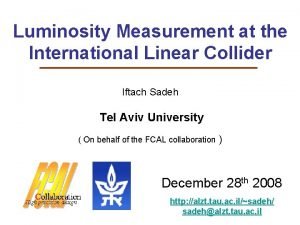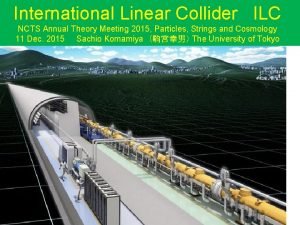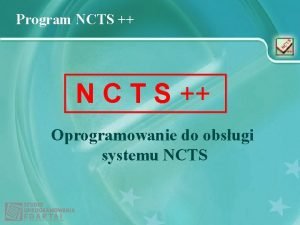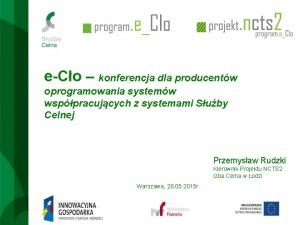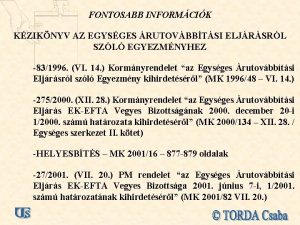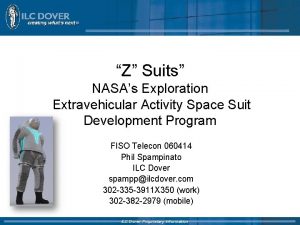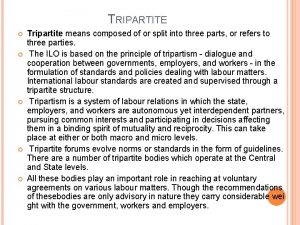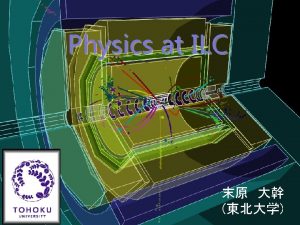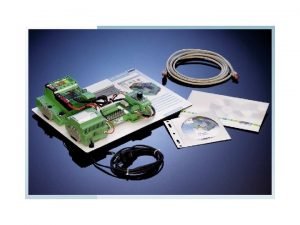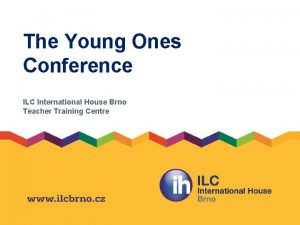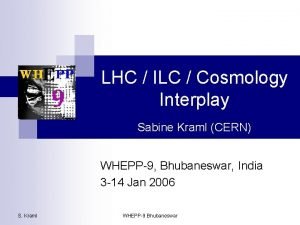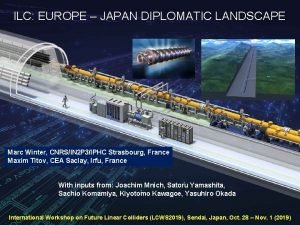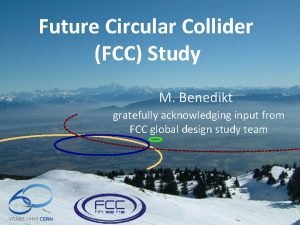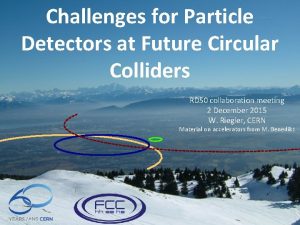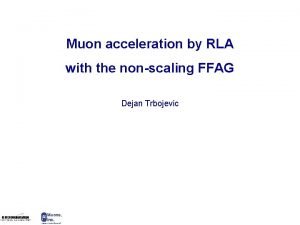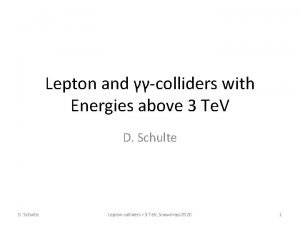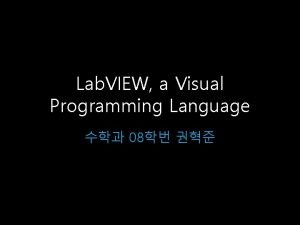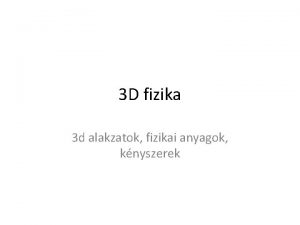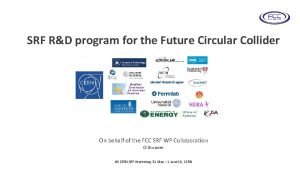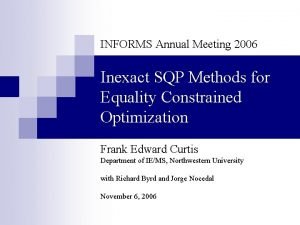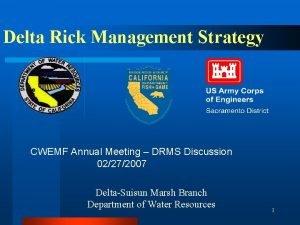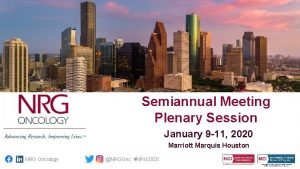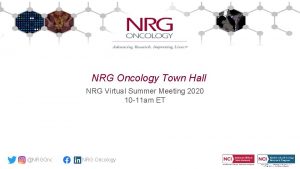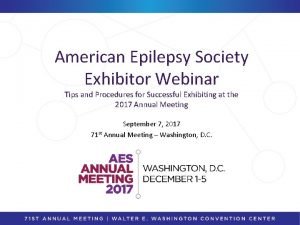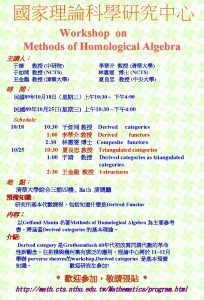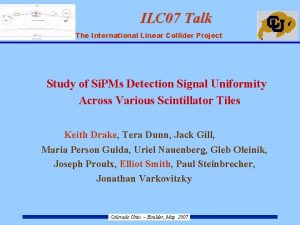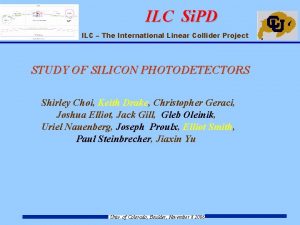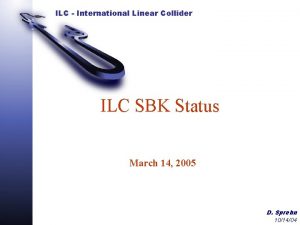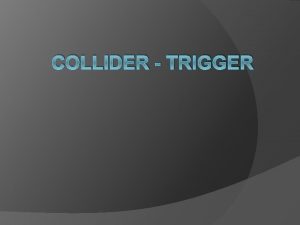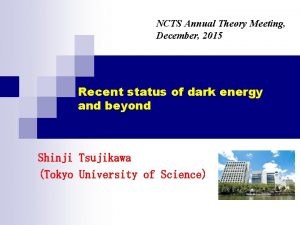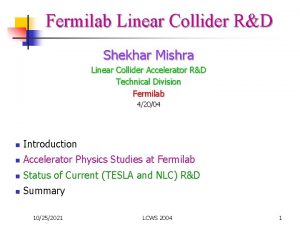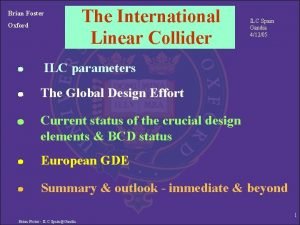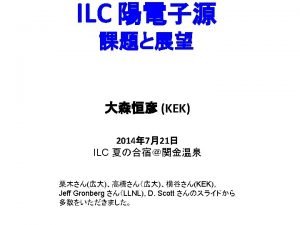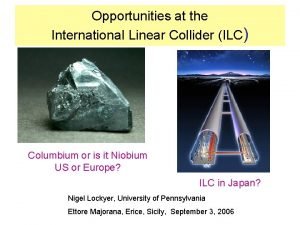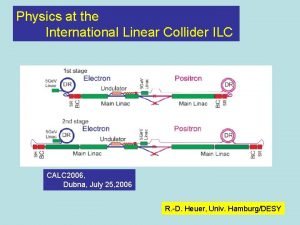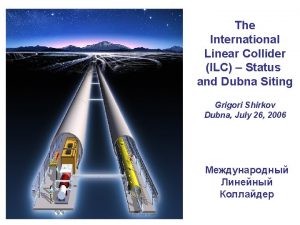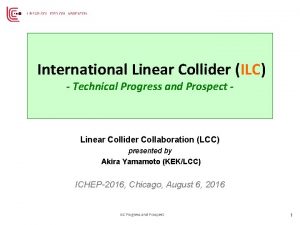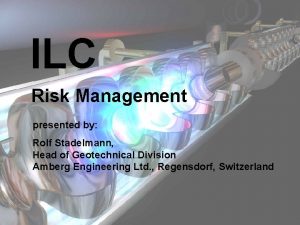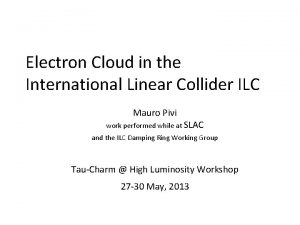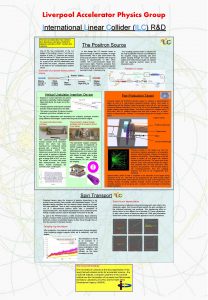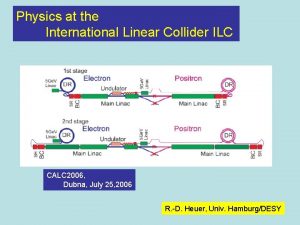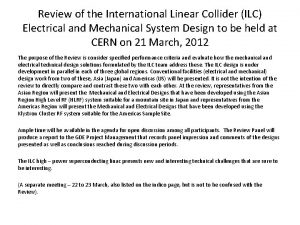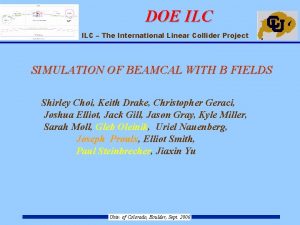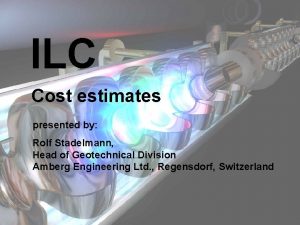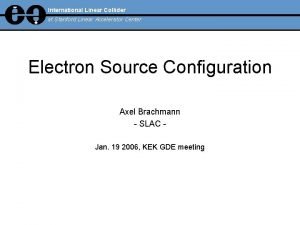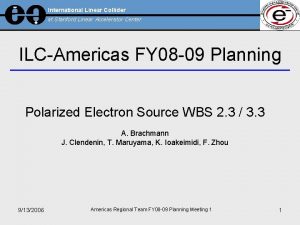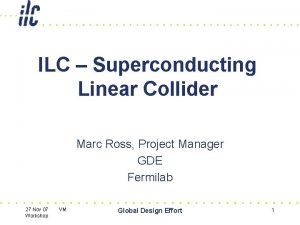International Linear Collider ILC NCTS Annual Theory Meeting


















![polarization [K. Fujii] 20 polarization [K. Fujii] 20](https://slidetodoc.com/presentation_image/513ebd52796eb85101c8d35410147f45/image-19.jpg)
















- Slides: 35

International Linear Collider ILC NCTS Annual Theory Meeting 2015, Particles, Strings and Cosmology 11 Dec. 2015 Sachio Komamiya (駒宮幸男) The University of Tokyo 1

International Linear Collider I Physics II Accelerator Technology III Project Implementation

I Physics For over 50 years, synergic interactions between theorists and experimentalists of particle physics led to the establishment of a framework, the Standard Model. Advanced high-energy accelerators have contributed significantly to these processes. This effort is completed by the discovery of the Higgs Boson at the LHC in 2012. However, there are still important aspects of nature that cannot be explained by the Standard Model. (1) We know that the elementary particles obtain masses due to their interaction with the Higgs field condensed in the vacuum. However, why the Higgs Boson is condensed in the vacuum ? (2) Why there are three generations of quarks and leptons, as well as three types of interactions linking them ? Why do the masses of quarks and leptons vary over many orders of magnitudes, ranging from sub-e. V neutrinos to the top

(3) What is the identity of the invisible Dark Matter that pervades the universe, amount of which is about five times that of ordinary matter ? (4) Despite the existence of matter and antimatter in equal amounts immediately after the Big Bang, why did tiny surplus of matter servive, providing the basis of our very existence ? (5) What is the Dark Energy, which causes the accelerating expansion of the current universe ? Why the Dark Energy has the energy density of O(me. V 4) ? What causes the Inflation of the Universe ? (6) The Standard Model does not encompass theory of gravity, so how can we comprehend the universe in the moments immediately after its birth ? Experimental Particle Physics is not at all completed ! see (1) (3) and (5) There must be new physics beyond the Standard Model between the Electro-weak scale and the Planck scale.

Toward a fundamental theory Gravity Strong Weak EM Age of Universe 13. 8 byr 380 kyr Many observables at the EW scale 10 -10 s Electroweak “Unification” ILC 10 -36 s 10 -43 s Grand Unification ? Quantum Gravity ?

electron-positron vs proton-proton collision Ex. Higgs boson production electron-positron collision e+ e Z qq, ll, νν H bb Z proton-proton collision hadrons p g t H g p bb hadrons Low background, the simplest initial state, low collision rate. ⇒ ideal detector can be designed Collision energy of elementary process is fixed and controlled. Four momentum conservation can be used in analyses. ⇒ high precision experiments A proton is a composite particle ⇒ complicated interactions high radiation environment very high event frequency ⇒requires advanced detector technologies (triggering) and smart ideas in the analyses. 6

Story of Top Quark and Higgs Boson Importance of synergy between hadron and e+e- colliders From precise electroweak measurements at LEP, top mass was predicted Discovery to Top Measurement of Precise Top mass at the TEVATRON Discovery of Higgs at LHC Higgs Z top Z Z Higgs mass is restricted into a narrow mass range using precise top mass and LEP/SLC electro-weak data 114 Ge. V <M ~ H< 160 Ge. V Z Precise measurements of Higgs properties at ILC 7

LHC H→γγ Invariant mass of γγ hadrons p g t γγ H g p hadrons ILC Recoil mass of Z(μ+μ-) Z e+ e μ +μ - Z H X

Three Steps of Higgs Boson Studies at ILC Step 1: m. H, σ(ZH), Branching fractions at 250 Ge. V Step 2: σ(ννH) ⇒ Γ(H) total at 500 Ge. V Higgs-strahlung peaks around 250 Ge. V WW fusion dominates at high energies Step 3: Higgs self-coupling at 500 -1000 Ge. V H H 9

Precise Measurement of Higgs Coupling Higgs boson: elementary or composite? Supersymmetry (MSSM) Composite Higgs (MCHM 5) ILC 250+500 Lumi. Up Δ(αs /π)= 0. 4% Δmb /mb < 0. 7% Able to distinguish models with specific patterns 10

Precise Measurement of Higgs Coupling Higgs boson: elementary or composite? Supersymmetry (MSSM) Composite Higgs (MCHM 5) ILC 250+ 550 Lumi. Up 11

Higgs Self-Coupling Motivation to measure Higgs Boson self-coupling ・Discover the interaction that makes Higgs condense in the vacuum ・Direct probe of the Higgs potential ⇒ EWSB mechanism ・Test electroweak baryogenesis ・The deviation from the SM value can be large Challenging measurement because of: • Small cross section (Zhh 0. 2 fb at 500 Ge. V) • Many jets in the final state • Presence of interference diagrams 12

expected precision of λ ZHH ννHH Gap of these two expectations ⇒ room of improvement For ZHH: 500 Ge. V is the optimal energy, δλ/λ ~ 6% : 30%, but rather mild dependence between around 500 -600 Ge. V, significantly worse if much lower or higher than that for ννHH: significantly better going from 500 Ge. V to 1 Te. V, δλ/λ~ 10% achievable when Ecm >= 1 Te. V; better precision at higher ecm, but not drastically, from 1 Te. V to 3 Te. V, improved by 50% Junping Tian Keisuke Fujii LCWS 2015 14

Impact of Top quark precise measurements Precise top quark mass is measured by energy scanning ⇒ vacuum stability Beam polarization is essential to distinguish left/right-handed couplings. Deviation in tt. Z coupling ⇒ 60 Me. V SM/SUSY LHC ILC SM/SUSY LHC, Ref. ar. Xiv: 1311. 2028 ILC, Ref. ar. Xiv: 1307. 8102

Supersymmetry at ILC LHC Experiments put severe limits on SUSY. The gluino is excluded up to the mass of ~1. 3 Te. V at LHC Run 1. This gluino mass limit is valid for wide range of models. This does not mean that the Te. V scale SUSY is dead. The mass relation of some SUSY breaking models Gravity mediated SUSY breaking M(Gluino)/M(LSP_bino) ~ 7 Anomaly mediated SUSY breaking M(Gluino)/M(LSP_wino)~10 For LHC at 14 Te. V with 3000 fb-1 expected gluino mass reach is ~2. 3 Te. V. If we believe the above ratios, accessible mass region of the corresponding electro-weak gauginos (EWinos) at 500 Ge. V ILC is comparable. EWino searches at 1 Te. V ILC can reach more than the mass region which corresponds to the 2. 3 Te. V gluino. 16

However, if bino or wino is mixed with Higgsino, LSP is always lighter than the bino or wino pure state. Many models tells that the mass difference (ΔM) between the lightest SUSY particle (LSP Dark Matter candidate) and the next lightest SUSY particle is expected to be small. It is very hard to search these regions by the LHC experiments. LHC limits for the Electro-weak gaugino or Higgsino sectors are not severe. In any case ILC will search for light EWkinos and Higgsinos (or their mixture of Neutralinos and Charginos) 17

Search for Light SUSY Particles (Dark Matter Candidate) Tag the Initital State Radiation Higgsino like (M 1, M 2, μ, tanβ) point is randomly chosen 0. 05<M 1, M 2, μ<2 Te. V, 1<tanβ<70 Calculate LSP and the lightest chargino masses LSP Bino-like M 1 < M 2, μ Wino-like M 2 < M 1, μ Higgsino-like μ < M 1, M 2 18

Power of Beam Polarization μ beam μ Production of smuon 電子スピン無偏極 Electron polariization (90%) Background
![polarization K Fujii 20 polarization [K. Fujii] 20](https://slidetodoc.com/presentation_image/513ebd52796eb85101c8d35410147f45/image-19.jpg)
polarization [K. Fujii] 20

Accelerator in TDR Technology II ILC Accelerator Damping Rings Polarised electron source e+ Main Linac Ring to Main Linac (RTML) (including bunch compressors) e- Main Linac E+ source Demonstrated in TDR Progress in 2014 -15 Parameters Value C. M. Energy 500 Ge. V Peak luminosity 1. 8 x 1034 cm-2 s-1 Beam Rep. rate 5 Hz Pulse duration 0. 73 ms Average current 5. 8 m. A (in pulse) FF beam size (y) 5. 9 nm E gradient in SCRF acc. cavity 31. 5 MV/m +/-20% Q 0 = 1 E 1021

15. 4 km 5. 1 km Main Linac e+ src 1. 3 km 1. 1 km bunch comp. Advantages of linear collider (1) No energy loss due to synchrotron radiation (c. f. circular collider ΔE ∝(E/m)4 R-1) (2) Extendability (length ⇒energy ) (3) Beam Polarization (4) Energy Scanning 2. 2 km BDS IP 125 Ge. V transport central region Challenges High gradient Superconducting RF reduce length⇒lower construction cost low power⇒ lower running cost Small beam size (small emmitance) 22 higher luminosity⇒lower running cost

Technical Readiness for the ILC (1) Superconducting RF System SRF Facilities anticipated for ILC Hub/Consortium DESY, E-XFEL IHEP, PKU CEA-Saclay, LAL-Orsay KEK TRIUMF FNAL/ILCTA, ANL Cornell JLAB SLAC, LCLS-II RRCAT AMTF @DESY/E-XFEL, CM STF-CFF @ KEK ASTA @ FNAL, TEDF @ JLab 23

SRF Facilities anticipated for ILC Hubs. and SRF Progress in 2014 – 2015 Technology globally matured to realize ILC DESY, E-XFEL IHEP, PKU CEA-Saclay, LAL-Orsay KEK TRIUMF FNAL/ILCTA, ANL Cornell JLAB SLAC, LCLS-II RRCAT STF 2, Individual cavity Gradient ~ 35 MV/m AMTF @DESY/E-XFEL, CM Ø 700 of 800 cavities are completed, w/ < 30 MV/m > STF-CFF @ KEK ASTA @ FNAL, TEDF @ JLab Cryomodule test at Fermilab reached < 31. 5 > MV/m, exceeding ILC specification

(2) Beam Size at the Int. Point (Final Focus) Progress at ATF 2 Local chromatic correction @ final focus Average Beam Size 44 nm observed, corresponding to 7 nm at ILC (Goal : 37 nm, corresponding to 6 nm at ILC) 25

ILC Site Candidate Location in Japan: Kitakami Expressway Earthquake-proof stable bedrock of granite. No faults cross the line. Oshu Shinkansen Sendai Ichinoseki Ofunato Kesen-numa IP Region 26

III Project Implementation International Organization after TDR ICFA FALC Chair: J. Mnich Program Adv. Committee PAC – Chair: N. Holtkamp KEK Planning Office for the ILC Regional Directors - B. Foster (EU) H. Weerts (AMs) A. Yamamoto (AS) Chair: J. Womersley Linear Collider Board LCB – Chair: S. Komamiya Linear Collider Collab. LCC - Director: L. Evans Deputy (Physics) – H. Murayama Assoc. Directors ILC Project Unit, Coordination Unit – M. Harrison (Deputy) H. Hayano, N. Walker CLIC – S. Stapnes Physics & Detectors – H. Yamamoto 27

Supports from the World European Strategy approved by CERN Council, EC June 2013 Chair: Tatsuya Nakada (Swiss Federal Institute of Technology Lausanne) 28 Asia ACFA-HEP Statement on ILC Chair: Mitsuaki Nozaki (KEK) July 2013 USA Particle Physics Project Prioritization Panel (P 5) Report, May 2014 Chair: Steve Ritz (UC Santa Cruz)

The Position of MEXT and the Japanese Government towards the ILC being studied officially by the MEXT Japan Science Council of Japan Recommendation in 2013 MEXT ILC Taskforce formed in 2013 Commissioned Survey by NRI ILC Advisory Panel in JFY 2014 ~ ( in 2014, and 2015) Particle & Nuclear Phys. Working Group TDR Validation Working Group in 2014 ~ 2015 Human Resources Working Group in 2015

Federation of Diet members to promote a construction of international laboratory for ILC 31 st July 2008 established a suprapartisan ILC supporters (July 2008〜) President Kaoru Yosano Deputy Yukio Hatoyama Secretary. General Takeo Kawamura Directors Yoshihiko Noda Director Norihisa Tamura Masamitsu Naito White House July 2014 Renewed on 1 st Feb 2013 lead by Takeo Kawamura New Officers Supreme advisor Kaoru Yosano President Takeo Kawamura Secretary-general Tatsu Shionoya > 150 Diet Members Supporter of Industrial Sector : Advanced Accelerator Association of Japan (AAA) Established in June 2008 ⇒ Reformed as a general incorporated organization in 2014 Industry: 100 companies (Mitsubishi HI、Toshiba、Hitachi、Mitsubishi Electric、Kyoto Ceramic et al. ) Academy: 40 institutes (KEK,Tokyo、Kyoto、Tohoku, Kyushu, RIKEN, JAEA et al. ) AAA homepage http: //aaa-sentan. org Supreme advisor Kaoru Yosano President Emeritus Masatoshi Koshiba President Takashi Nishioka (Mitsubishi HI) Trustee Masanori Yamauchi (KEK) 〃 Akira Maru (Hitachi)、 〃 Yasuyuki Ito (Mitsubishi Electric) 〃 Shigenori Shiga (Toshiba)、 〃 Akira Noda (Kansei University) 〃 Masayuki Inagaki (Kyoto ceramic) Auditor Sachio Komamiya (The University of Tokyo) December 2011 at AAA symposium

Summary n n ILC is a truly global project. ICFA (International Committee for Futur Accelerators) oversees the project. ILC is complementary/synergic to the LHC (including HL-LHC). Clean environment, energy extendability, beam polarization, energy scanning n n n Discovery of physics beyond “the Standard Model” is anticipated at ILC through precise Higgs/top studies and new particle searches. The ILC accelerator technology is mature and solid. i. e. superconducting RF, beam focusing at collision Japan is seriously investigating hosting the ILC project as in the official process. Sign of willingness to participate in the project from governments outside Japan is essential. In Japan, the Federation of Diet Members, Industrial sectors, local governments powerfully support the ILC project. Non-formal diplomatic discussions has been already started among the governments.

A Big Branching is ahead of us ? Although Higgs was discovered , we do not know the origin of the electro-weak symmetry breaking. Higgs Boson is elementary Higgs Boson is composite Supersymmetry explains why the elementary Higgs boson is condensed in the vacuum. Discovery of SUSY particles is expected. Higgs Boson is a firmly bound state of unknown elementary particles by a new strong interaction which causes vacuum condensation. More bound states are expected In the Te. V mass region.

ILC Detector R&D (ILD, Si. D) • • • Return Yoke Vertex Detector: pixel detectors & low HCAL ECAL material budget TPC (Time Projection Chamber: high resolution ETD & low material budget, MPGD readout) Beam line SET Calorimeters: high granularity sensors, 5 x 5 mm 2 (ECAL)、3 x 3 cm 2 (HCAL) VTX Sensor Size ILC ATLAS Ratio Vertex 5× 5 mm 2 400× 50 mm 2 x 800 Tracker 1× 6 mm 2 13 mm 2 x 2. 2 ECAL 5× 5 mm 2 (Si) 39× 39 mm 2 x 61 Coil Forward components SIT FTD ~15 m Particle Flow Algorithm Charged particles Tracker, Photons ECAL, Neutral Hadrons HCAL Separate calorimeter clusters at particle level àuse best energy measurement for each particle. àoffers unprecedented jet energy resolution State-of-the-art detectors can be designed for ILC 33

Project Implementation Planning The authors of this document are scientists experienced in the organisation of large scientific projects. …. As was also the case for the original PIP published in conjunction with the ILCTDR, the purpose of this document is not to pre-empt necessary discussion among governments and funding authorities; rather it attempts to put forward possible solutions to important aspects of the running and foundation of a new international laboratory, seen to be acceptable and viable by the particle physics community, for their consideration and as an aid to their discussions. Brian Foster Chair of the LCB Subcommittee on Governance Contents 9. Industrialisation and Mass 1. Executive Summary Production of the SCRF 2. Introduction and General Linac Components Principles 10. Project Schedule 3. Governance 11. Intellectual Property 4. Funding Models 12. Interface between ILC Laboratory & 5. Project Management the Detectors 6. Host Responsibilities 13. Transitional arrangements 7. Siting Issues 14. Future Technical Activities 8. In-Kind Contribution Models They critically studied the existing large projects of ITER, CERN, EXFEL, ESS, OIST, . . . to find an optimal form of ILC governance.

Necessary steps towards the approval 1. Technology Choice (2003) 2. R&D and design of the machine/detectors by the international team ⇒ Technical Design Report (2013) 3. Official investigation and reviews of the ILC project by MEXT (now) 4. Clarify the scientific and technical issues in the report of the ILC Advisory Panel (now) 5. To facilitate / prepare intergovernmental discussions for sharing of cost human resources and the schedule without commitment (starting). 6. 7. 8. MEXT green signal Endorsement of CSTP (Council of Science, Technology and Innovation; chair: Prime Minister ) Cabinet decision 9. International agreement with commitment ⇒ Establishment of ILC Lab 35

Time line for the ILC project Years need 2 Preparation period Continuation of high-tech R&D (now) 4 Preparation for the ILC construction (with real budget) 9 Construction 6 th year - Start Installation 7 th year- Start of step-by-step accelerator test 1 Beam Commissioning ~8 Physics Run (500 Ge. V, 350 Ge. V, 250 Ge. V) ~ Run with Luminosity upgrade (500 Ge. V, 250 Ge. V) TBD Energy upgrade (~ 1 Te. V) 36
 International linear collider
International linear collider Positron vs proton
Positron vs proton Menu ncts
Menu ncts Help desk ncts
Help desk ncts Ncts árutovábbítás
Ncts árutovábbítás Zsuits
Zsuits Ilc and slc
Ilc and slc Ilc 2013
Ilc 2013 Ilc ing
Ilc ing Zora rutar ilc
Zora rutar ilc Boom chicka boom
Boom chicka boom Kaon cp violation
Kaon cp violation David i
David i Fcc collider
Fcc collider Fcc collider
Fcc collider Muon collider
Muon collider Muon collider
Muon collider Visual basic programming language
Visual basic programming language Unity sphere collider
Unity sphere collider Hadron collider
Hadron collider Hadron collider
Hadron collider Martinello colider
Martinello colider Informs annual meeting
Informs annual meeting Aupha annual meeting
Aupha annual meeting American psychiatric association annual meeting 2020
American psychiatric association annual meeting 2020 Masonic lodges in kentucky
Masonic lodges in kentucky Cwemf
Cwemf How to run an annual general meeting
How to run an annual general meeting Nrg oncology meeting 2017
Nrg oncology meeting 2017 Aashto annual meeting 2015
Aashto annual meeting 2015 Scts annual meeting
Scts annual meeting Nrg oncology meeting 2016
Nrg oncology meeting 2016 American epilepsy society annual meeting 2017
American epilepsy society annual meeting 2017 For today's meeting
For today's meeting Meeting objective
Meeting objective What is meeting and types of meeting
What is meeting and types of meeting
